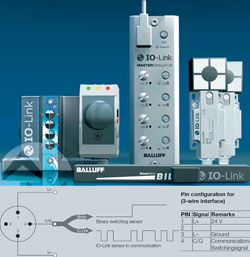
The performance capability of modern machines and systems in factory and process automation has increased remarkably in recent years and decades.
The machines are not only faster, smaller and more reliable, but at the same time have become safer and more flexible.
This kind of progress has been made possible by innovation in automation technology at all levels, from control technology to fieldbus or the sensor/actuator level. The demands for more and more functions, parameterisation and especially diagnostics, follows the increasingly common integration of microcontrollers in sensors and actuators which enables them to meet these demands. The general term here is 'intelligent' sensors or actuators.
Bottlenecks
However, there is one area where progress has been slow: the interface connecting the sensors/actuators to the automation systems. This interface always represents a 'bottleneck' when it comes to adding diagnostics information or parameter data to the actual process signal.
A specific example here is a photoelectric sensor (diffuse type) which in addition to a contamination indicator, also offers adjustable background suppression. Transmission of the contamination info using today's technology requires additional wiring plus an additional input point on the controller. This adds complexity and cost, and so oftentimes many a practical function remains unused.
In response to these difficulties, IO-Link was defined as a point-to-point connection between sensor/actuator and the I/O module. IO-Link eliminates the bottleneck by making today's binary standard sensor interface capable of communication.

Standards compatibility
When defining IO-Link, investment security was important. Thus IO-Link sensors and actuators can be connected to existing I/O modules at any time. Likewise, for a sensor that does not 'speak', IO-Link can still be connected to an IO-Link I/O module. This module recognises communication-capable sensors/actuators after power-up and establishes IO-Link communication, or if appropriate, reverts to standard switching mode.
Especially important in terms of cabling, is 100% mechanical compatibility. This means that familiar, inexpensive and unshielded standard industrial cable can be used for all IO-Link slaves - regardless of their complexity. This advantage becomes particularly apparent when one compares this with shielded or multiconductor cables, not to mention their accompanying assembly and installation problems.
Process and service data
Whereas today's binary connection of sensors and actuators is designed to send process data as a single bit (switching state info), this bottleneck is permanently eliminated with IO-Link. Here there is a process data channel and a service data channel, over which 2 bytes each can be sent in a typical 2 ms cycle. This not only increases the amount of process data significantly, but also satisfies current demands with respect to diagnostics and parameter data transmission.
Analog sensor integration?
Analog sensors are used whenever a simple binary signal is no longer sufficient, such as when a motion controller needs to know the exact position of a moving part. The integration of analog sensors is still a fair effort in today's automation topologies. In addition to the more expensive analog input and output channels, the required signal-to-noise ratios often require greater effort and expense, eg, to achieve true 12-bit resolution, the noise component in a 10 V data signal needs to remain under 1 to 2 mV! The use of costly, difficult to use shielded cable is usually unavoidable. With IO-Link it is possible to send an already digitised value over cost-effective, unshielded cable, without fear of noise interference.
Aside from the IO-Link box, no additional components are required for the analog inputs or outputs. In addition to optimal utilisation, which in most cases results in a reduction in the number of boxes, the variety is reduced to only one type. For systems operators and maintenance personnel the savings potential is enormous. There is a lot involved in the A/D conversion in the sensor, not to mention the fact that digital values are already present in many sensors. Additionally, IO-Link reduces cabling and terminating costs while at the same time eliminating mistakes when wiring a multiconductor cable.
| Tel: | +27 11 786 0553 |
| Email: | [email protected] |
| www: | www.retron.co.za |
| Articles: | More information and articles about Retron |

© Technews Publishing (Pty) Ltd | All Rights Reserved